Nikola Banić
NTIRE 2024 Challenge on Night Photography Rendering
Jun 18, 2024



Abstract:This paper presents a review of the NTIRE 2024 challenge on night photography rendering. The goal of the challenge was to find solutions that process raw camera images taken in nighttime conditions, and thereby produce a photo-quality output images in the standard RGB (sRGB) space. Unlike the previous year's competition, the challenge images were collected with a mobile phone and the speed of algorithms was also measured alongside the quality of their output. To evaluate the results, a sufficient number of viewers were asked to assess the visual quality of the proposed solutions, considering the subjective nature of the task. There were 2 nominations: quality and efficiency. Top 5 solutions in terms of output quality were sorted by evaluation time (see Fig. 1). The top ranking participants' solutions effectively represent the state-of-the-art in nighttime photography rendering. More results can be found at https://nightimaging.org.
Illumination Estimation Challenge: experience of past two years
Dec 31, 2020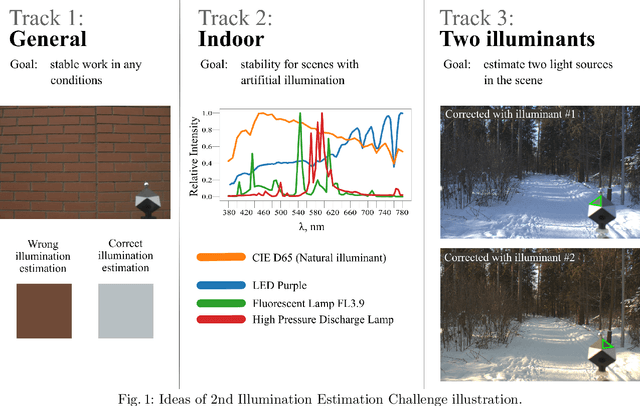
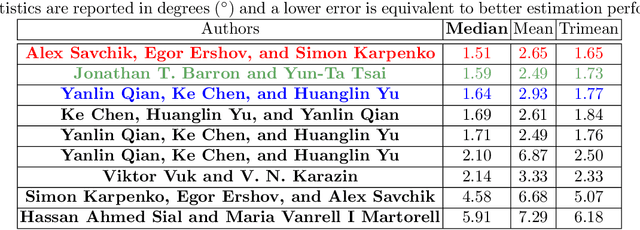
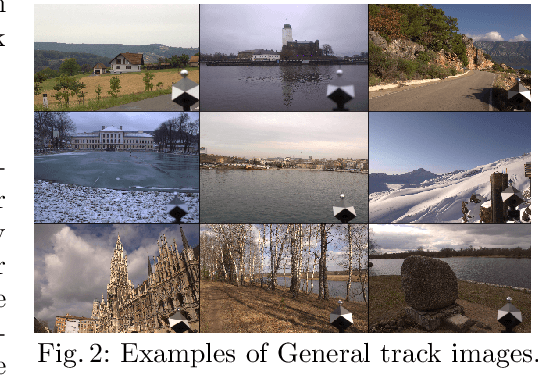
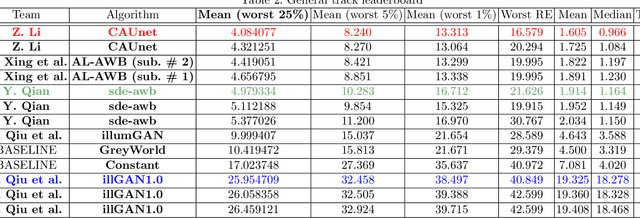
Abstract:Illumination estimation is the essential step of computational color constancy, one of the core parts of various image processing pipelines of modern digital cameras. Having an accurate and reliable illumination estimation is important for reducing the illumination influence on the image colors. To motivate the generation of new ideas and the development of new algorithms in this field, the 2nd Illumination estimation challenge~(IEC\#2) was conducted. The main advantage of testing a method on a challenge over testing in on some of the known datasets is the fact that the ground-truth illuminations for the challenge test images are unknown up until the results have been submitted, which prevents any potential hyperparameter tuning that may be biased. The challenge had several tracks: general, indoor, and two-illuminant with each of them focusing on different parameters of the scenes. Other main features of it are a new large dataset of images (about 5000) taken with the same camera sensor model, a manual markup accompanying each image, diverse content with scenes taken in numerous countries under a huge variety of illuminations extracted by using the SpyderCube calibration object, and a contest-like markup for the images from the Cube+ dataset that was used in IEC\#1. This paper focuses on the description of the past two challenges, algorithms which won in each track, and the conclusions that were drawn based on the results obtained during the 1st and 2nd challenge that can be useful for similar future developments.
The Cube++ Illumination Estimation Dataset
Nov 19, 2020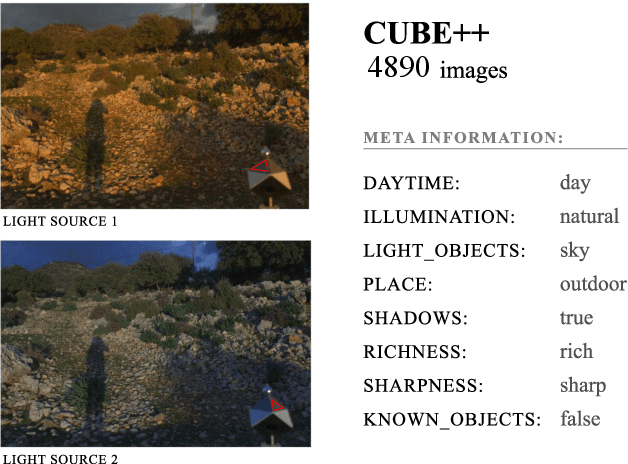

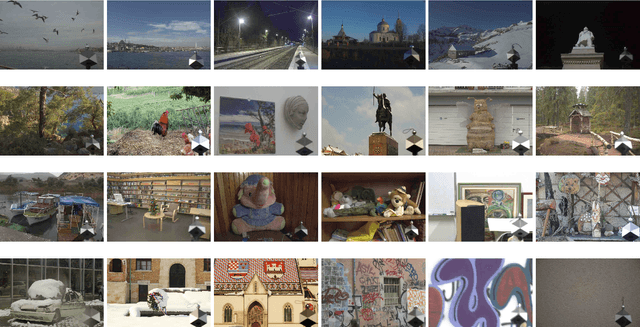

Abstract:Computational color constancy has the important task of reducing the influence of the scene illumination on the object colors. As such, it is an essential part of the image processing pipelines of most digital cameras. One of the important parts of the computational color constancy is illumination estimation, i.e. estimating the illumination color. When an illumination estimation method is proposed, its accuracy is usually reported by providing the values of error metrics obtained on the images of publicly available datasets. However, over time it has been shown that many of these datasets have problems such as too few images, inappropriate image quality, lack of scene diversity, absence of version tracking, violation of various assumptions, GDPR regulation violation, lack of additional shooting procedure info, etc. In this paper, a new illumination estimation dataset is proposed that aims to alleviate many of the mentioned problems and to help the illumination estimation research. It consists of 4890 images with known illumination colors as well as with additional semantic data that can further make the learning process more accurate. Due to the usage of the SpyderCube color target, for every image there are two ground-truth illumination records covering different directions. Because of that, the dataset can be used for training and testing of methods that perform single or two-illuminant estimation. This makes it superior to many similar existing datasets. The datasets, it's smaller version SimpleCube++, and the accompanying code are available at https://github.com/Visillect/CubePlusPlus/.
CroP: Color Constancy Benchmark Dataset Generator
Mar 29, 2019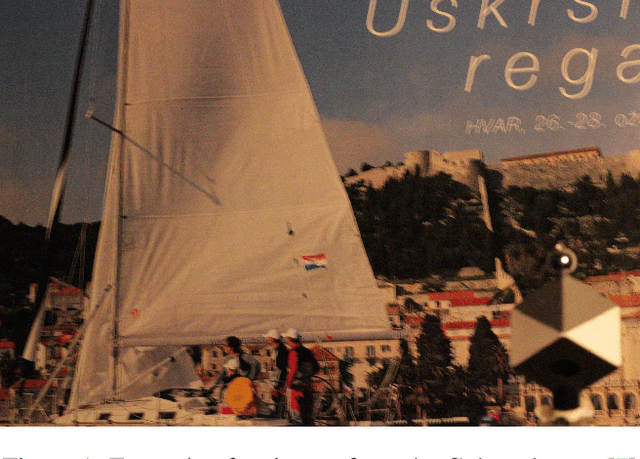
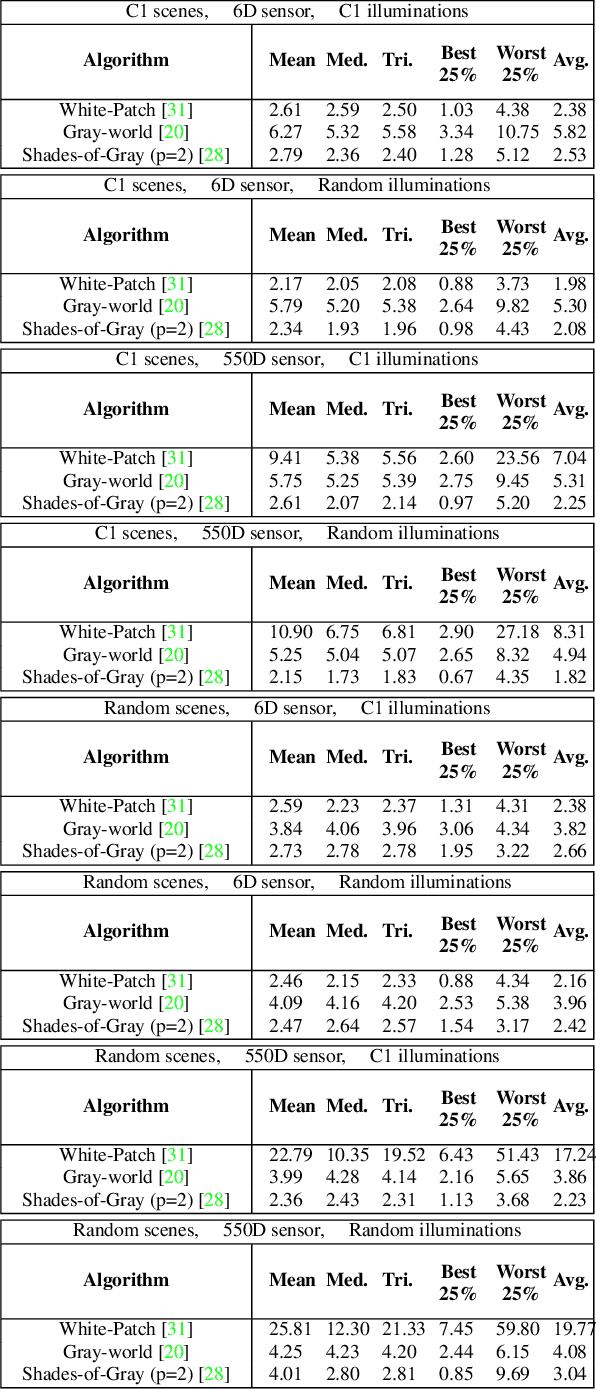
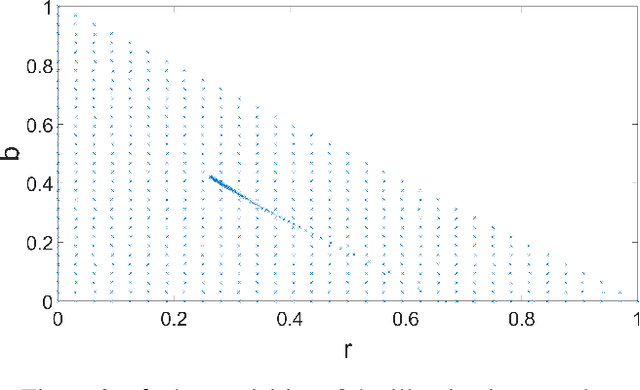
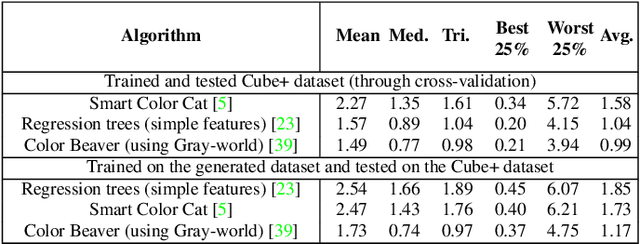
Abstract:Implementing color constancy as a pre-processing step in contemporary digital cameras is of significant importance as it removes the influence of scene illumination on object colors. Several benchmark color constancy datasets have been created for the purpose of developing and testing new color constancy methods. However, they all have numerous drawbacks including a small number of images, erroneously extracted ground-truth illuminations, long histories of misuses, violations of their stated assumptions, etc. To overcome such and similar problems, in this paper a color constancy benchmark dataset generator is proposed. For a given camera sensor it enables generation of any number of realistic raw images taken in a subset of the real world, namely images of printed photographs. Datasets with such images share many positive features with other existing real-world datasets, while some of the negative features are completely eliminated. The generated images can be successfully used to train methods that afterward achieve high accuracy on real-world datasets. This opens the way for creating large enough datasets for advanced deep learning techniques. Experimental results are presented and discussed. The source code is available at http://www.fer.unizg.hr/ipg/resources/color_constancy/.
The Past and the Present of the Color Checker Dataset Misuse
Mar 11, 2019
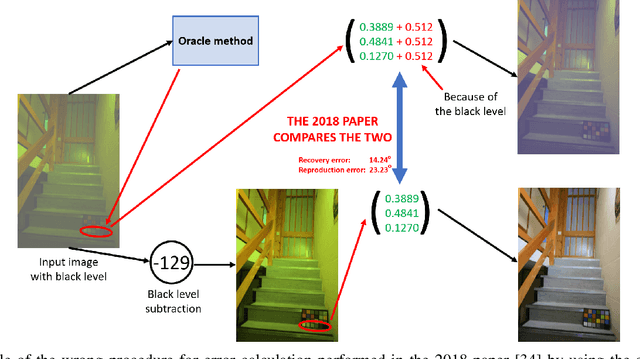
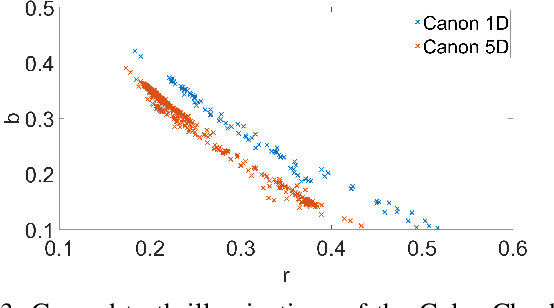
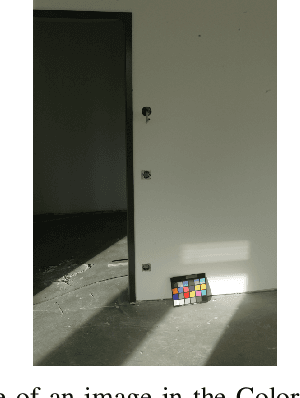
Abstract:The pipelines of digital cameras contain a part for computational color constancy, which aims to remove the influence of the illumination on the scene colors. One of the best known and most widely used benchmark datasets for this problem is the Color Checker dataset. However, due to the improper handling of the black level in its images, this dataset has been widely misused and while some recent publications tried to alleviate the problem, they nevertheless erred and created additional wrong data. This paper gives a history of the Color Checker dataset usage, it describes the origins and reasons for its misuses, and it explains the old and new mistakes introduced in the most recent publications that tried to handle the issue. This should, hopefully, help to prevent similar future misuses.
Unsupervised Learning for Color Constancy
Apr 20, 2018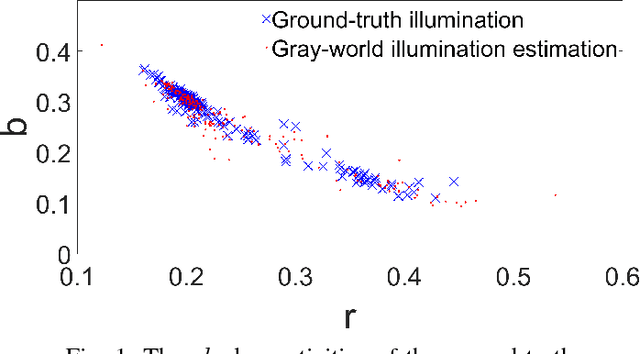
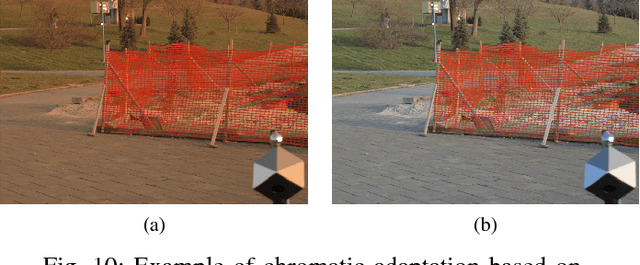
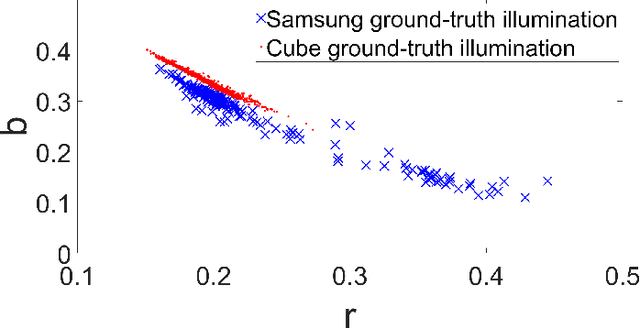

Abstract:Most digital camera pipelines use color constancy methods to reduce the influence of illumination and camera sensor on the colors of scene objects. The highest accuracy of color correction is obtained with learning-based color constancy methods, but they require a significant amount of calibrated training images with known ground-truth illumination. Such calibration is time consuming, preferably done for each sensor individually, and therefore a major bottleneck in acquiring high color constancy accuracy. Statistics-based methods do not require calibrated training images, but they are less accurate. In this paper an unsupervised learning-based method is proposed that learns its parameter values after approximating the unknown ground-truth illumination of the training images, thus avoiding calibration. In terms of accuracy the proposed method outperforms all statistics-based and many learning-based methods. An extension of the method is also proposed, which learns the needed parameters from non-calibrated images taken with one sensors and which can then be successfully applied to images taken with another sensor. This effectively enables inter-camera unsupervised learning for color constancy. Additionally, a new high quality color constancy benchmark dataset with 1365 calibrated images is created, used for testing, and made publicly available. The results are presented and discussed. The source code and the dataset are available at http://www.fer.unizg.hr/ipg/resources/color_constancy/.
Green Stability Assumption: Unsupervised Learning for Statistics-Based Illumination Estimation
Feb 02, 2018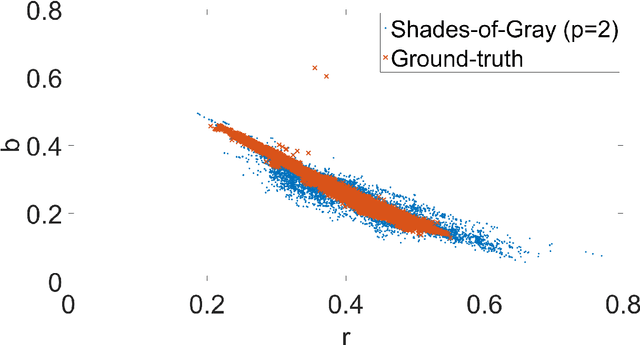

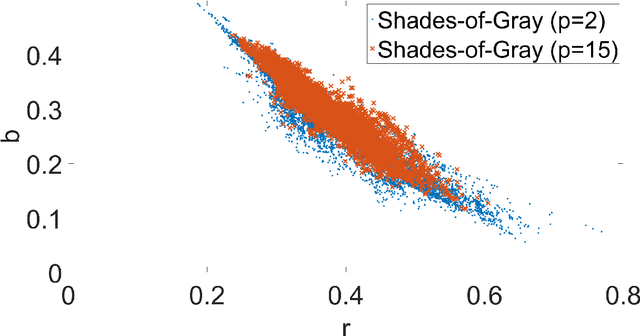
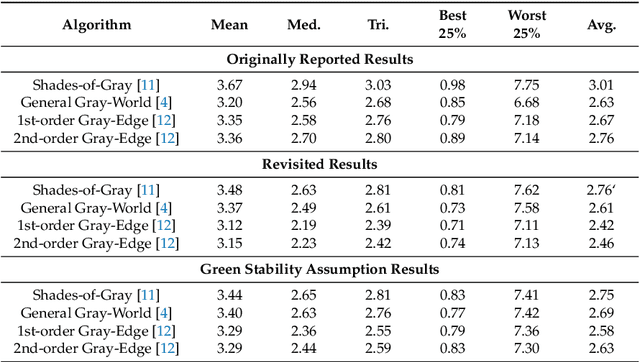
Abstract:In the image processing pipeline of almost every digital camera there is a part dedicated to computational color constancy i.e. to removing the influence of illumination on the colors of the image scene. Some of the best known illumination estimation methods are the so called statistics-based methods. They are less accurate than the learning-based illumination estimation methods, but they are faster and simpler to implement in embedded systems, which is one of the reasons for their widespread usage. Although in the relevant literature it often appears as if they require no training, this is not true because they have parameter values that need to be fine-tuned in order to be more accurate. In this paper it is first shown that the accuracy of statistics-based methods reported in most papers was not obtained by means of the necessary cross-validation, but by using the whole benchmark datasets for both training and testing. After that the corrected results are given for the best known benchmark datasets. Finally, the so called green stability assumption is proposed that can be used to fine-tune the values of the parameters of the statistics-based methods by using only non-calibrated images without known ground-truth illumination. The obtained accuracy is practically the same as when using calibrated training images, but the whole process is much faster. The experimental results are presented and discussed. The source code is available at http://www.fer.unizg.hr/ipg/resources/color_constancy/.
Using the Random Sprays Retinex Algorithm for Global Illumination Estimation
Oct 02, 2013


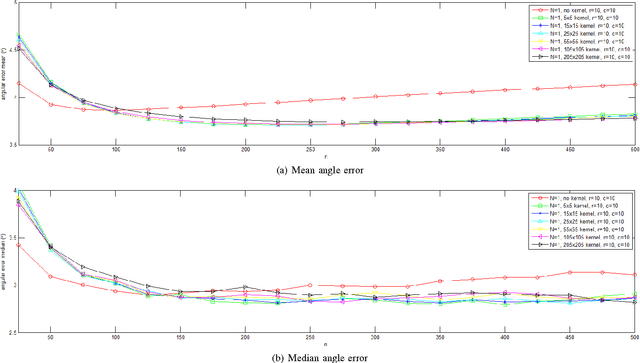
Abstract:In this paper the use of Random Sprays Retinex (RSR) algorithm for global illumination estimation is proposed and its feasibility tested. Like other algorithms based on the Retinex model, RSR also provides local illumination estimation and brightness adjustment for each pixel and it is faster than other path-wise Retinex algorithms. As the assumption of the uniform illumination holds in many cases, it should be possible to use the mean of local illumination estimations of RSR as a global illumination estimation for images with (assumed) uniform illumination allowing also the accuracy to be easily measured. Therefore we propose a method for estimating global illumination estimation based on local RSR results. To our best knowledge this is the first time that RSR algorithm is used to obtain global illumination estimation. For our tests we use a publicly available color constancy image database for testing. The results are presented and discussed and it turns out that the proposed method outperforms many existing unsupervised color constancy algorithms. The source code is available at http://www.fer.unizg.hr/ipg/resources/color_constancy/.
 Add to Chrome
Add to Chrome Add to Firefox
Add to Firefox Add to Edge
Add to Edge